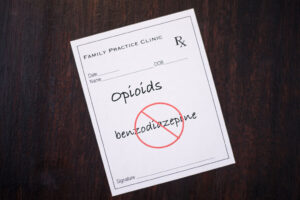
Understanding Opioid Narcotics: Risks, Treatment, and Recovery
Opioid narcotics, potent substances used for pain management, have become a focal point of public health discussions due to their high potential for addiction and
Fentanyl, a powerful synthetic opioid, has become a critical concern in the realm of addiction, demanding an effective approach to detoxification. Waismann Method has established itself as a leading rapid detox center for fentanyl, offering an advanced medical solution to those struggling with this challenging dependency. Recognizing the importance of a thorough and humane detox process, the Waismann Method® provides a comprehensive program tailored to foster complete detoxification, eliminate physical cravings, and accelerate the recovery of the nervous system.
Opting for the Waismann Method® for fentanyl detox means choosing a treatment that is not only rapid but also complete in its ability to address the physical and psychological facets of addiction. With a focus on individualized patient care, the center’s approach ensures that the complexities of each person’s experience with fentanyl are met with the highest level of medical expertise and compassionate support. This method is celebrated for its capacity to facilitate a smoother, more manageable transition to a life free from opioid dependence, setting a strong foundation for long-term recovery and health.
If you or a loved one is grappling with fentanyl addiction, discover the Waismann Method® difference today. Take the first step towards a clean slate and a healthier future by reaching out to us. Let’s begin your journey to recovery together.
Call for a confidential consultation.
Speak Confidentially
with an opiate detox treatment expert.
Fentanyl is a synthetic opioid, similar to morphine but 50 to 100 times more potent. Initially developed for pain management treatment of cancer patients, it is used in various medical contexts. However, due to its powerful opioid properties, fentanyl has become a drug with a high potential for abuse, leading to a significant rise in illicit use and fentanyl addiction. The drug works by binding to the body’s opioid receptors, which are found in areas of the brain that control pain and emotions. When opioid drugs like fentanyl attach to these receptors, they can drive up dopamine levels in the brain’s reward areas, producing a state of euphoria and relaxation, but also promoting addiction.
The development of fentanyl addiction can be insidious. It often begins with a legitimate prescription but can quickly escalate to misuse. Some individuals may seek the intensified effects of the drug by consuming it in higher doses or in more potent forms, often leading to dependency. The illicit market for fentanyl has also grown, with many users unknowingly consuming it when it’s mixed with other drugs, enhancing its danger and addictive potential.
The prevalence of fentanyl abuse has surged, leading to an alarming increase in overdose deaths. The drug’s high potency makes it deadly in small quantities, posing a significant risk even to experienced users. Fentanyl addiction can have devastating effects on health, leading to an array of issues including respiratory distress, mental health disorders, and increased susceptibility to infectious diseases. Moreover, the withdrawal from fentanyl can be particularly severe, with symptoms that are intense and difficult to manage without medical assistance.
Understanding fentanyl addiction is critical in the current climate, where opioid abuse has become an epidemic. Recognizing the signs and symptoms of fentanyl use and addiction is the first step toward addressing this pervasive issue. The impact on individuals, families, and communities is profound, necessitating comprehensive strategies for prevention, education, and treatment. With the right support and professional care, recovery from fentanyl addiction is possible, allowing individuals to reclaim their lives and well-being.
Recognizing the signs and symptoms of fentanyl use and addiction is crucial, as early detection can be lifesaving. Here are some common indicators:
Fentanyl withdrawal symptoms can be particularly severe, and the process requires careful management. Here’s a breakdown of what to expect:
Early Stage Symptoms (beginning 6-12 hours after last dose):
Peak Symptoms (1-3 days after last dose):
Extended Symptoms (up to weeks after last dose):
The timeline and intensity of fentanyl withdrawal symptoms can differ based on individual dependency levels and physiological factors. The Waismann Method®’s rapid detox does not utilize medication-assisted treatment (MAT), instead of focusing on a detoxification process that aims to alleviate physical dependency without substituting other opioids. This approach can often result in a quicker and more complete detoxification, eliminating physical cravings and facilitating the recovery of the nervous system without the need for long-term medication management.
The discomfort associated with withdrawal can be daunting, but with the expert care at the Waismann Method®, patients are provided with a safe and supportive environment. The process is managed with the utmost attention to the individual’s unique health needs, ensuring that the path to recovery is as smooth and comfortable as possible.
Medical detox is a crucial step in treating fentanyl addiction due to the substance’s high potency and the severe withdrawal symptoms that can occur. Fentanyl’s powerful effect on the central nervous system means that sudden cessation can lead to serious health risks, making medically supervised detox the safest option for individuals seeking recovery.
Here’s why medical detox is essential for fentanyl addiction:
Attempting detox without medical supervision can be dangerous, potentially leading to severe health consequences. Without the appropriate medical support, the individual is at risk of overdose should they relapse due to the decreased tolerance that comes with withdrawal. Medical detox differs from other detox methods by providing a structured, professional environment where patients can detox safely and are supported through every step of the process.
In essence, medical detox for fentanyl addiction is not just a recommendation; it is a critical component of the journey towards recovery, ensuring the process is as safe and effective as possible.
Rapid detox for fentanyl addiction is an advanced medical procedure that offers an expedited route to overcoming physical dependency. This process, performed under close medical supervision, typically unfolds as follows:
Rapid detox condenses the timeline of withdrawal, offering a swift and efficient path back to a life unburdened by opioid dependence.
By undergoing sedation, patients bypass the peak of withdrawal discomfort, allowing for a more serene detoxification experience.
This advanced detox method effectively purges the body of opioids, dramatically reducing the urge to use, thereby setting a strong foundation for sustained sobriety.
Rapid detox initiates a faster recalibration of the nervous system, expediting the body’s natural healing mechanisms and restoring balance more quickly.
Freed from the grips of physical addiction, patients gain the clarity and stability needed to delve into and address the psychological underpinnings of their addiction, fostering a more mindful and grounded recovery journey.
Understanding the complexities of the post-detox phase, the Waismann Method® strongly advocates for comprehensive care during the initial days of recovery. To address this crucial need, we established Domus Retreat — a serene and secure sanctuary where our patients receive constant professional care. At Domus, the recovery journey is supported by a range of therapeutic services, ensuring each individual’s transition is not only safer and more comfortable but also geared towards a more successful long-term recovery.
When selecting a rapid detox program for fentanyl addiction, the decision must be informed by several crucial considerations to ensure the highest standard of care:
In the path to overcoming fentanyl addiction, choosing the right rapid detox program is a critical step that lays the foundation for successful and sustainable recovery. It’s a choice that should be approached with careful consideration of these vital factors.
if you’re seeking a path away from fentanyl dependence, the Waismann Method® provides a proven, personalized rapid detox that adapts to your specific health needs. With our commitment to medical excellence and patient-centered care, we offer you the best chance for a successful recovery. Take the definitive step towards reclaiming your life — contact us today to discuss how our tailored detox protocols can pave the way for your healthy, opioid-free future. Your new beginning starts with the Waismann Method Rapid Detox. Call 1(800)423-2482
Celebrating a Quarter Century as America's Premier Rapid Detox Center.
Seek Freedom from Fentanyl Addiction Today — Get the Help You Deserve
What's New at Waismann Method®

Opioid narcotics, potent substances used for pain management, have become a focal point of public health discussions due to their high potential for addiction and

In today’s fast-paced world, the conversation around prescription medication misuse, particularly the mixing of benzodiazepines (benzos) and opiates, has become more crucial than ever. While

Welcome to your comprehensive guide on safely navigating the world of OTC (over-the-counter) drugs. In this essential read, we dive into critical tips and strategies



Get Newsletter Updates from Waismann Method®
"*" indicates required fields
We are available 7 days a week
DISCLAIMER: The text presented on this page is not a substitute for professional medical advice. It is for your information only and may not represent your true individual medical situation. Do not hesitate to consult your healthcare provider if you have any questions or concerns. Do not use this information to diagnose or treat a health problem or disease without consulting a qualified healthcare professional. Be advised that Opiates.com articles are derived from various sources and may not reflect your own country’s regulations.